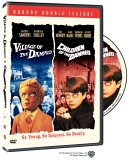Synopsis
Village of the Damned (1960) is the best of the films based on the novels of JohnWyndham (in this case the sources is The Midwich Cuckoos. At 11 o’clock onemorning, every living thing in Midwich falls asleep. Hours later, all awake, apparently none theworse. But shortly thereafter, it turns out that every woman capable of bearing children ispregnant. When the babies are born, they are all blond, eerily similar, and possessed offrightening intelligence and powe….
Children of the Damned (1963) is less a sequel than a completely different storyusing some of the same elements. Rather than 12 children in Midwich, there are six überkidsaround the world. They are gathered in their various countries’ embassies in London, but escapeand barricade themselves in a derelict church. The powers-that-be are torn between fearing thechildren and wanting to wipe them out, and wanting to harness their abilities to the arms race.Much tragedy ensues.
Both films are superb examples of SF/horror. Each has a different tone and look(Village’s deceptively peaceful and soft rural look contrasting Children’s muchgrittier urban scene). The scripts are intelligent, and the casts are superb, ranging from the alwaysdelightful George Sanders and Hammer-mainstay Barbara Shelley in the first to ex-Avenger IanHendry (so kind here, yet so sleazily menacing in the original Get Carter) in the second.The children are pure evil in the first and the children chosen to play the invaders are incrediblycreepy to behold. In the second film, they look more like ordinary children, and gradually becomethe focus of audience sympathy as the real villains are geo-political power plays. Children ofthe Damned is just as savage in its denunciation of Cold War politics as Dr.Strangelove, and ends with what is one of the most bitterly ironic shots in science fictioncinema.
Audio
Both films are presented in the original mono, thus sparing us from ill-considered remixes.The mono is solid, particularly in the case of Children of the Damned. The earlier filmdoes have some background hiss (noticeable in the frequent eerie silences) and some minor buzzon the dialogue now and then.
Video
Lovely anamorphic widescreen transfers for both films. Though there is a tiny bit of flickernow and then, and some minor grain (whose level varies from nil to very noticeable in stockshots), the black-and-white tones are wonderful (and the two very different styles of the twofilms show just how much range B&W is capable of), there is no edge enhancement, and theimages are very sharp.
Special Features
Apart from the theatrical trailers, each film also has its own commentary. Film scholar SteveHaberman does the honours on the first film, and his talk is very smart and informative, thoughhe does seem to run out of steam a bit about 25 minutes in, and tends to recount matters that,while interesting, are rather tangential to the movie itself. John Briley talks about his script forChildren of the Damned, and how pointed his political message was. The main menuscreen for each film is scored.
Closing Thoughts
Classic films with solid commentaries on one disc. Life is good.
Special Features List
- 2 Audio Commentaries
- Theatrical Trailers






